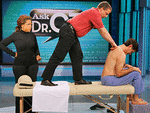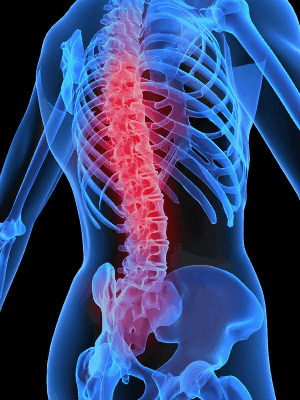
Back Pain
Back pain is one of humanity’s most common complaints. It is generally called dorsalgia, but it comes in a variety of forms, including the very common lumbago, which is lower back pain or low back pain. Back pain is the second most common neurological ailment in the world — only headache is more common.
Back pain may be classified anatomically - neck pain, upper back pain, lower back pain or tailbone pain – or by duration - acute (back pain for less than 4 weeks), subacute (back pain for 4 – 12 weeks) or chronic (back pain for greater than 12 weeks).
Why is your back so susceptible?
Your back supports your entire body, using a complex interconnecting network of nerves, joints, muscles, tendons and ligaments. All these components are capable of producing pain in back, low back and surrounding areas. Because the back is connected to the rest of your body, it also means that pain in back can be an early warning of underlying conditions elsewhere in your body.
Large nerves that originate in the spine and go to the legs and arms can make pain radiate to the extremities. The pain may be felt in the neck (and might radiate into the arm and hand), in the upper back, or in the low back, (and might radiate into the leg or foot), and may include symptoms other than pain, such as weakness, numbness or tingling.
The Rolfing Approach To Back Pain
Rolfing is a systematic programme of postural repatterning that seeks to bring your body back into alignment. Thus Rolfing continuously seeks out a dynamic, creative balance in your body that is quite different from holding it in one rigid postural position.
Rolfing sees the body and its structure as a series of interconnected and inter-related bony segments. As a Rolfer will explain to you, your body is designed to provide internal support for all these segments. Large sections rest on sections below them and provide support for sections that are above them. In this case, the back, especially the lower back, provides internal support for almost all of your body.
To understand how Rolfing treatment for the back works, it is important to recognize that the back pain cannot be understood by looking at the back alone.
Dr. Ida Rolf, a pioneer in body work, perfected the technique structural integration called Rolfing. According to Dr. Rolf, the traditional idea of standing up straight, shoulders back, stomach in and head high, actually misaligns the spine and deforms the skeleton.
Rolfing operates through a sequence of hands-on manipulation, the Rolfers move the tissue of the back and lower back toward symmetry and balance that the body demands by stretching and moving the tissue.
The Rolfing Treatment For The Back
Rolfing is designed to loosen the fascia, resulting in a freedom of muscle movement and the unlearning of bad patterns of muscle strain and misuse, resolving the source of the back pain. This release should then enable the back to properly align itself. When the back is properly aligned, back pain should recede. For low back pain as well as disk herniation, Rolfing would focus on softening, releasing, and lengthening the muscle tissue and creating space between the intervertebral disks (most easily seen when Rolfing creates space between the pelvis and the ribs). Some of the key muscles involved in Rolfing for back pain will possibly be the muscles involved in hip flexion and the connective tissue which surrounds them as well as the various lower back muscles and the strong ligaments that hold the sacrum in place (the sacrum is the triangular bone at the base of your spine which you might know as the tailbone)
The Advantages of Rolfing For Your Back
Rolfing’s great strength is that it is non-invasive, and hence while undergoing Rolfing you will be able to continue with daily life and even sports, while simultaneously treating and relaxing your back muscles, which will eventually allow you a greater range of movement and increase your flexibility. It is crucial to understand that Rolfing will treat the body not as individual parts, but as a whole, so the whole organism realigns. Then, movement education would be provided to help prevent future recurrence of the problem.
back pain
|

Certified Rolfer®
Vincent Lee
Rolfing was featured in


“Two Hands” 2007 Academy Award. Nominated for documentary film.

Andrew Weil, M.D.
“Good Morning From Dr. Weil.com” An on-line daily newsletter published a health news brief June 25, 2004--“Tip: Is Your Posture Bad? Today’s Tip-Rolfing."
